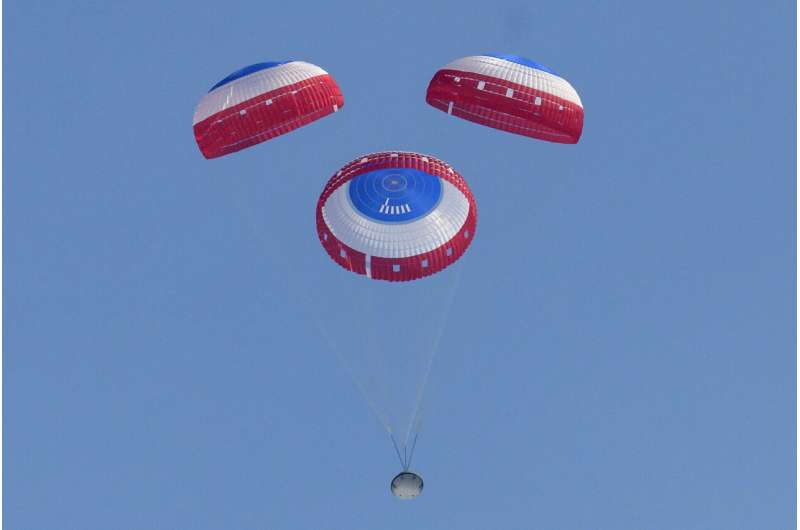
Copernical Team
NRO awards Maxar 10-year deal under the Electro-Optical Commercial Layer Acquisition program
 Maxar Technologies (NYSE:MAXR) reports it has been awarded an Electro-Optical Commercial Layer (EOCL) contract by the U.S. National Reconnaissance Office (NRO). EOCL, a five-year base contract with five additional years of options through 2032, represents the largest ever commercial imagery acquisition contract awarded by the NRO.
Under the award agreement, Maxar will continue to provide h
Maxar Technologies (NYSE:MAXR) reports it has been awarded an Electro-Optical Commercial Layer (EOCL) contract by the U.S. National Reconnaissance Office (NRO). EOCL, a five-year base contract with five additional years of options through 2032, represents the largest ever commercial imagery acquisition contract awarded by the NRO.
Under the award agreement, Maxar will continue to provide h Momentus Launches First Demonstration Flight on SpaceX Falcon 9
 Momentus Inc. (NASDAQ: MNTS) has launched its first demonstration flight of the Vigoride orbital transfer vehicle to low-earth orbit aboard the SpaceX Transporter-5 mission. Momentus also announced that it has placed its first customer satellite in orbit and plans to conduct more deployments of customer payloads in the coming days.
The versatile Vigoride spacecraft, designed to support a r
Momentus Inc. (NASDAQ: MNTS) has launched its first demonstration flight of the Vigoride orbital transfer vehicle to low-earth orbit aboard the SpaceX Transporter-5 mission. Momentus also announced that it has placed its first customer satellite in orbit and plans to conduct more deployments of customer payloads in the coming days.
The versatile Vigoride spacecraft, designed to support a r US Govt awards Planet EOCL contract
 Planet Labs PBC (NYSE: PL), a leading provider of daily data and insights about Earth, today announced that the National Reconnaissance Office (NRO) has selected Planet Labs Federal, Inc. (Planet Federal), Planet's wholly owned subsidiary, for an award to the Electro-Optical Commercial Layer (EOCL) contract.
EOCL is the U.S. government's industry-defining procurement vehicle for unclassifi
Planet Labs PBC (NYSE: PL), a leading provider of daily data and insights about Earth, today announced that the National Reconnaissance Office (NRO) has selected Planet Labs Federal, Inc. (Planet Federal), Planet's wholly owned subsidiary, for an award to the Electro-Optical Commercial Layer (EOCL) contract.
EOCL is the U.S. government's industry-defining procurement vehicle for unclassifi Spaceflight Inc. debuts its latest OTV, Sherpa-AC
 Spaceflight Inc., the leading global launch services provider, today announced it has contacted its Sherpa-AC vehicle and confirmed the vehicle is operating nominally. This is the debut launch of Sherpa-AC, the latest variation in the company's Sherpa orbital transfer vehicle (OTV) portfolio.
The Transporter 5 rideshare mission on board a SpaceX Falcon 9 lifted off from Cape Canaveral on M
Spaceflight Inc., the leading global launch services provider, today announced it has contacted its Sherpa-AC vehicle and confirmed the vehicle is operating nominally. This is the debut launch of Sherpa-AC, the latest variation in the company's Sherpa orbital transfer vehicle (OTV) portfolio.
The Transporter 5 rideshare mission on board a SpaceX Falcon 9 lifted off from Cape Canaveral on M LeoLabs to support Japan Air Self Defense Force with Commercial Space Domain Awareness
 LeoLabs, Inc., the world's leading commercial provider of low Earth orbit (LEO) mapping and Space Situational Awareness (SSA) services, has announced a multimillion-dollar award to provide data and services for the Japan Air Self Defense Force (JASDF). The agreement offers Japan access to the largest set of actionable insights in existence for tracking satellites and orbital debris in low Earth
LeoLabs, Inc., the world's leading commercial provider of low Earth orbit (LEO) mapping and Space Situational Awareness (SSA) services, has announced a multimillion-dollar award to provide data and services for the Japan Air Self Defense Force (JASDF). The agreement offers Japan access to the largest set of actionable insights in existence for tracking satellites and orbital debris in low Earth NanoAvionics and Gama to set sails in space
 Gama, a French space startup, has contracted mission integrator NanoAvionics for a demonstration of Gama's solar sails propulsion system in low Earth orbit (LEO). Under the mission agreement, NanoAvionics will provide its 6U nanosatellite bus, payload integration services, a satellite testing campaign, launch services and satellite operations. The launch of the "Alpha" nanosatellite is scheduled
Gama, a French space startup, has contracted mission integrator NanoAvionics for a demonstration of Gama's solar sails propulsion system in low Earth orbit (LEO). Under the mission agreement, NanoAvionics will provide its 6U nanosatellite bus, payload integration services, a satellite testing campaign, launch services and satellite operations. The launch of the "Alpha" nanosatellite is scheduled SpaceX's Transporter 5 launches with remains of 47 people for 'space burial'
 SpaceX launched its 22nd rocket of the year on Wednesday, the Transporter-5 rideshare mission, which included carrying 47 people's cremated remains for a burial in space.
The send off, designed by the company Celestis, marks the 18th time the company has launched space burial flights - which have increased in recent years at least partially because of commercial space companies like SpaceX
SpaceX launched its 22nd rocket of the year on Wednesday, the Transporter-5 rideshare mission, which included carrying 47 people's cremated remains for a burial in space.
The send off, designed by the company Celestis, marks the 18th time the company has launched space burial flights - which have increased in recent years at least partially because of commercial space companies like SpaceX NASA, Boeing complete Starliner uncrewed flight test to ISS
 NASA and Boeing safely landed the company's CST-100 Starliner spacecraft Wednesday in the desert of the western United States, completing the uncrewed Orbital Flight Test-2 (OFT-2) to the International Space Station to help prove the system is ready to fly astronauts.
About four hours after departing the space station, Starliner touched down onto its airbags at 4:49 p.m. MDT, wrapping up t
NASA and Boeing safely landed the company's CST-100 Starliner spacecraft Wednesday in the desert of the western United States, completing the uncrewed Orbital Flight Test-2 (OFT-2) to the International Space Station to help prove the system is ready to fly astronauts.
About four hours after departing the space station, Starliner touched down onto its airbags at 4:49 p.m. MDT, wrapping up t Boeing capsule lands back on Earth after space shakedown

Boeing's crew taxi returned to Earth from the International Space Station on Wednesday, completing a repeat test flight before NASA astronauts climb aboard.
It was a quick trip back: The Starliner capsule parachuted into the New Mexico desert just four hours after leaving the orbiting lab, with airbags attached to cushion the landing. Only a mannequin was buckled in.
Aside from thruster failures and cooling system snags, Starliner appeared to clinch its high-stakes shakedown cruise, 2 1/2 years after its botched first try. Flight controllers in Houston applauded and cheered the bull's-eye touchdown.
"It's great to have this incredible test flight behind us," said Steve Stich, director of NASA's commercial crew program. He described the demo as "extremely successful," with all objectives met.
What can satellites reveal about climate tipping points?

The effects of our warming climate are seen across a multitude of measures, usually as incremental changes: more frequent extreme weather, heatwaves, droughts and wildfires. The cumulative impact of these changes, however, can cause fundamental parts of the Earth system to change more quickly and drastically. These ‘tipping points’ are thresholds where a tiny change pushes the system into an entirely new state.
This week, at ESA’s Living Planet Symposium, scientists came together to discuss the latest research evidence for climate tipping points and identify the opportunities and challenges of using remote sensing data to understand them.
